BA4F04 - Financial Resources Management: Financial Performance
VerifiedAdded on 2024/06/04
|13
|2563
|153
Report
AI Summary
This report provides a comprehensive financial analysis of Stratford Yachts Ltd., differentiating between management and financial accounting and outlining key financial statements used by both profit and non-profit organizations. It identifies various stakeholders and their specific information needs, f...
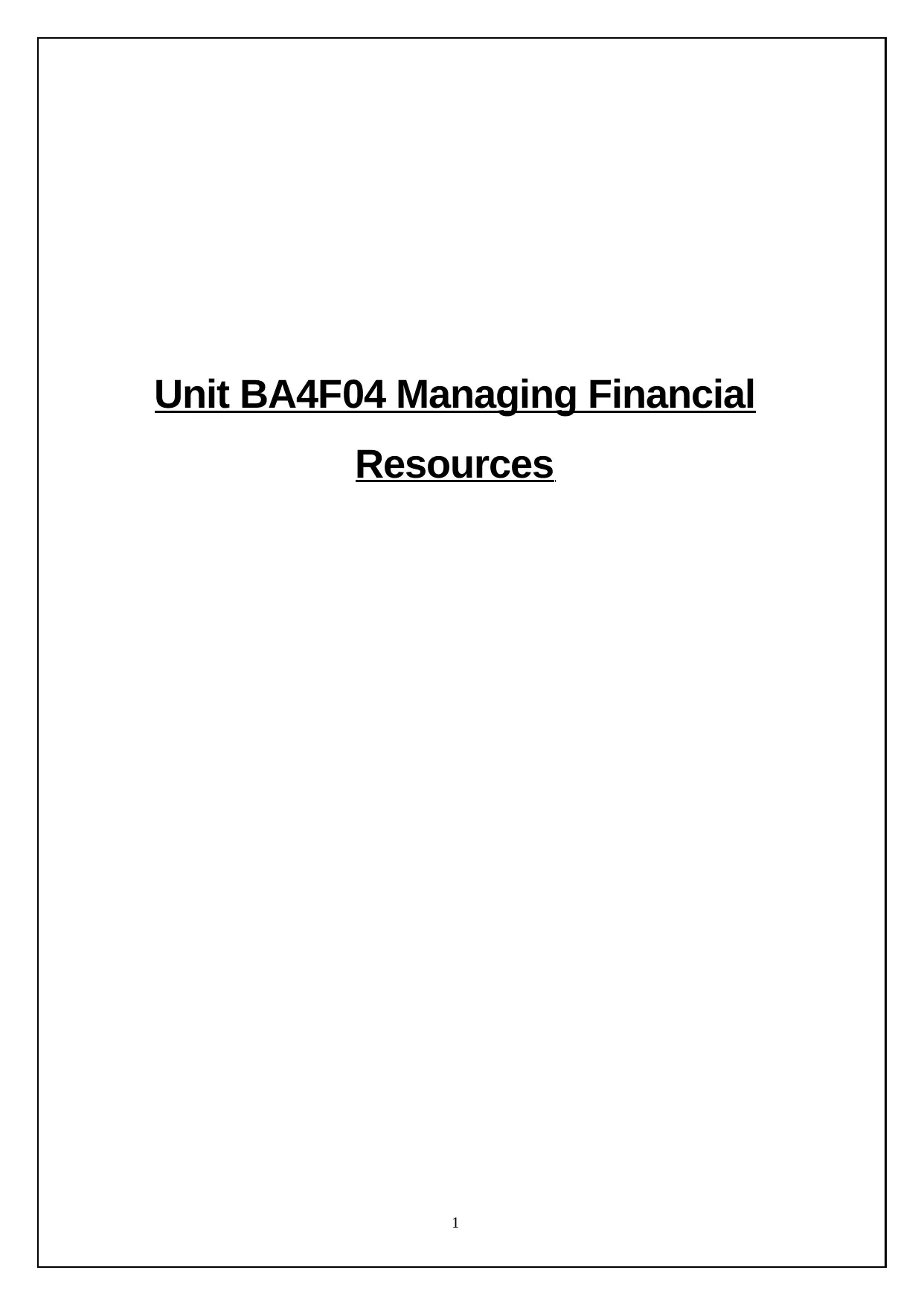
Unit BA4F04 Managing Financial
Resources
1
Resources
1
Paraphrase This Document
Need a fresh take? Get an instant paraphrase of this document with our AI Paraphraser
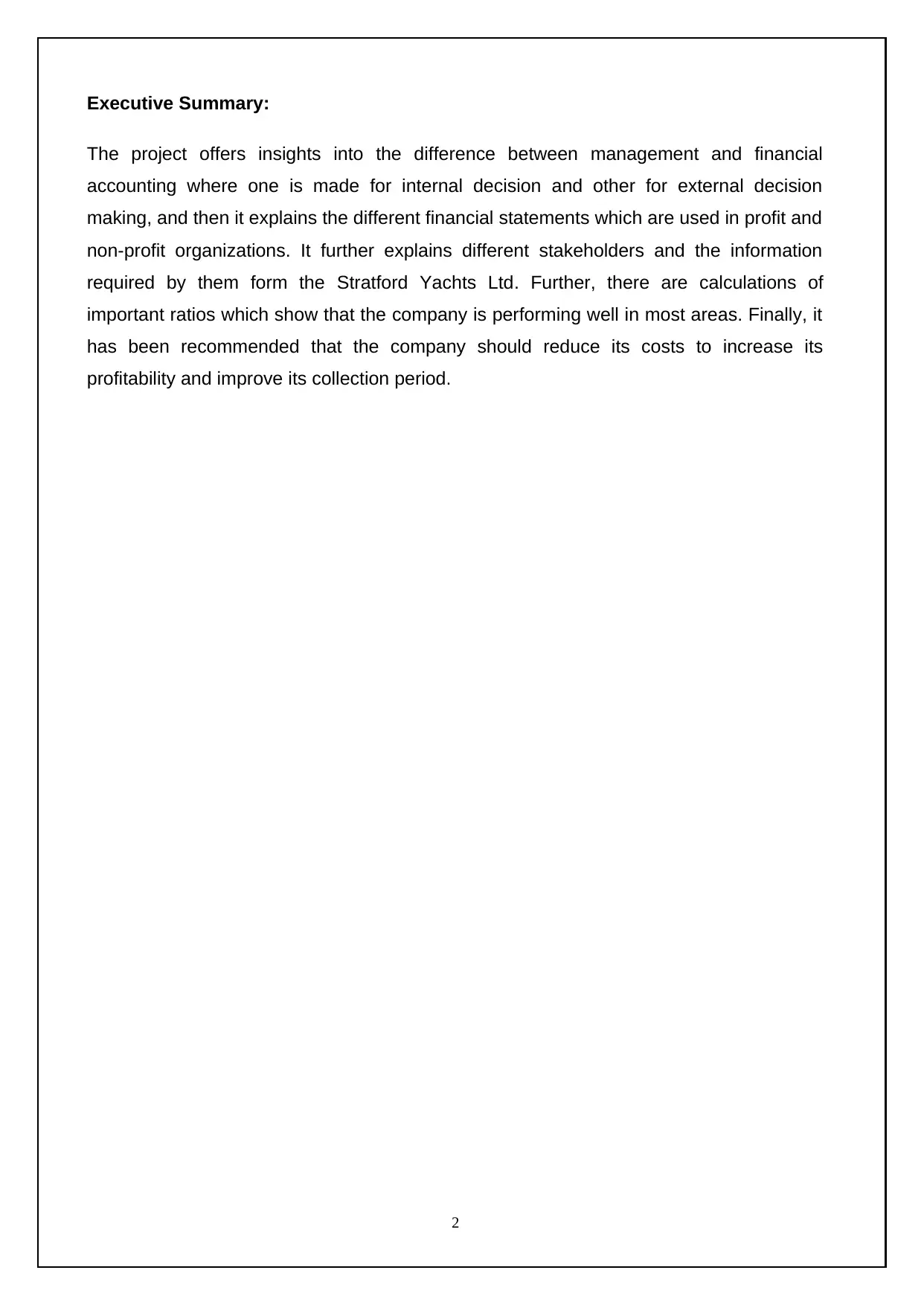
Executive Summary:
The project offers insights into the difference between management and financial
accounting where one is made for internal decision and other for external decision
making, and then it explains the different financial statements which are used in profit and
non-profit organizations. It further explains different stakeholders and the information
required by them form the Stratford Yachts Ltd. Further, there are calculations of
important ratios which show that the company is performing well in most areas. Finally, it
has been recommended that the company should reduce its costs to increase its
profitability and improve its collection period.
2
The project offers insights into the difference between management and financial
accounting where one is made for internal decision and other for external decision
making, and then it explains the different financial statements which are used in profit and
non-profit organizations. It further explains different stakeholders and the information
required by them form the Stratford Yachts Ltd. Further, there are calculations of
important ratios which show that the company is performing well in most areas. Finally, it
has been recommended that the company should reduce its costs to increase its
profitability and improve its collection period.
2
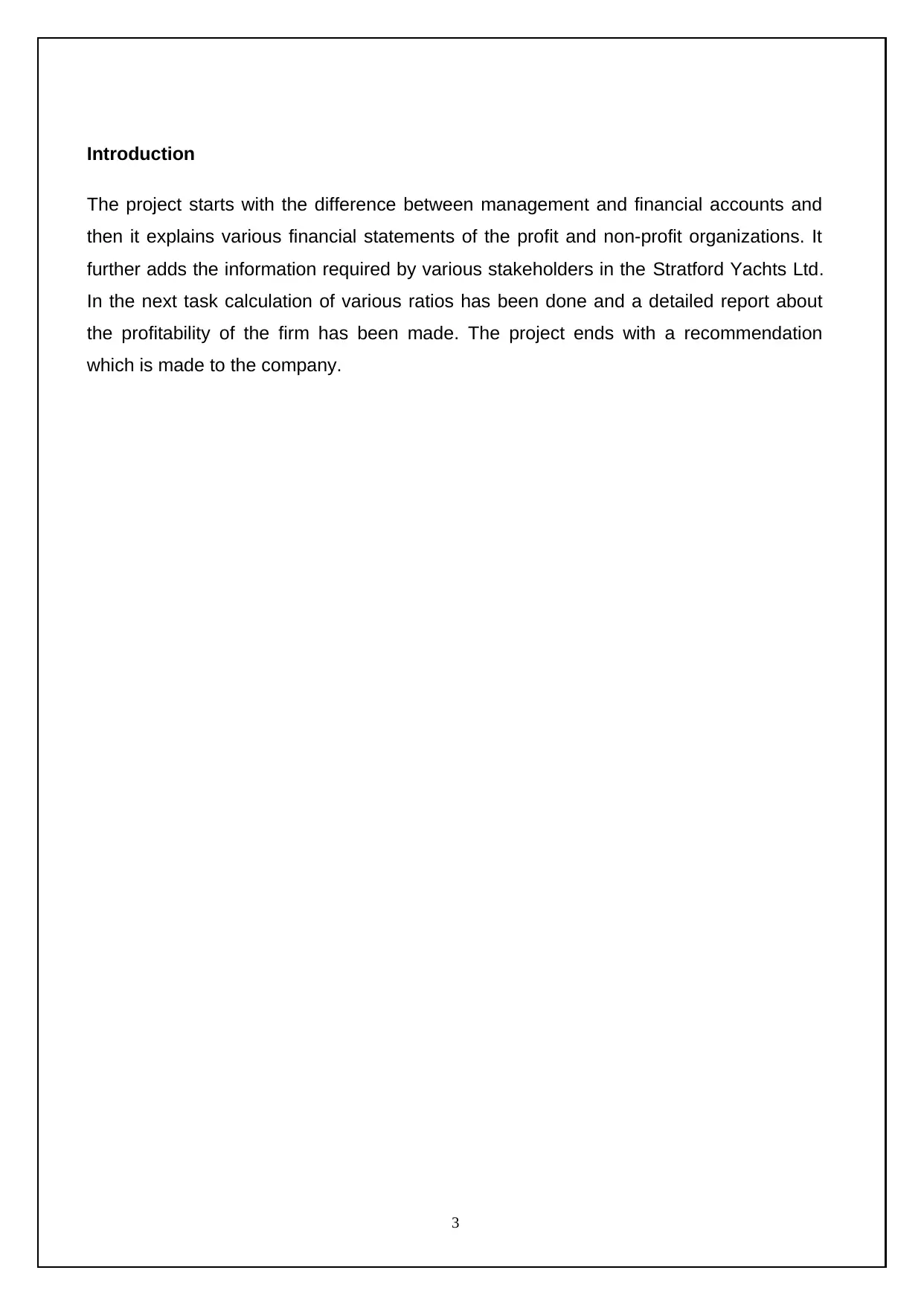
Introduction
The project starts with the difference between management and financial accounts and
then it explains various financial statements of the profit and non-profit organizations. It
further adds the information required by various stakeholders in the Stratford Yachts Ltd.
In the next task calculation of various ratios has been done and a detailed report about
the profitability of the firm has been made. The project ends with a recommendation
which is made to the company.
3
The project starts with the difference between management and financial accounts and
then it explains various financial statements of the profit and non-profit organizations. It
further adds the information required by various stakeholders in the Stratford Yachts Ltd.
In the next task calculation of various ratios has been done and a detailed report about
the profitability of the firm has been made. The project ends with a recommendation
which is made to the company.
3
⊘ This is a preview!⊘
Do you want full access?
Subscribe today to unlock all pages.

Trusted by 1+ million students worldwide
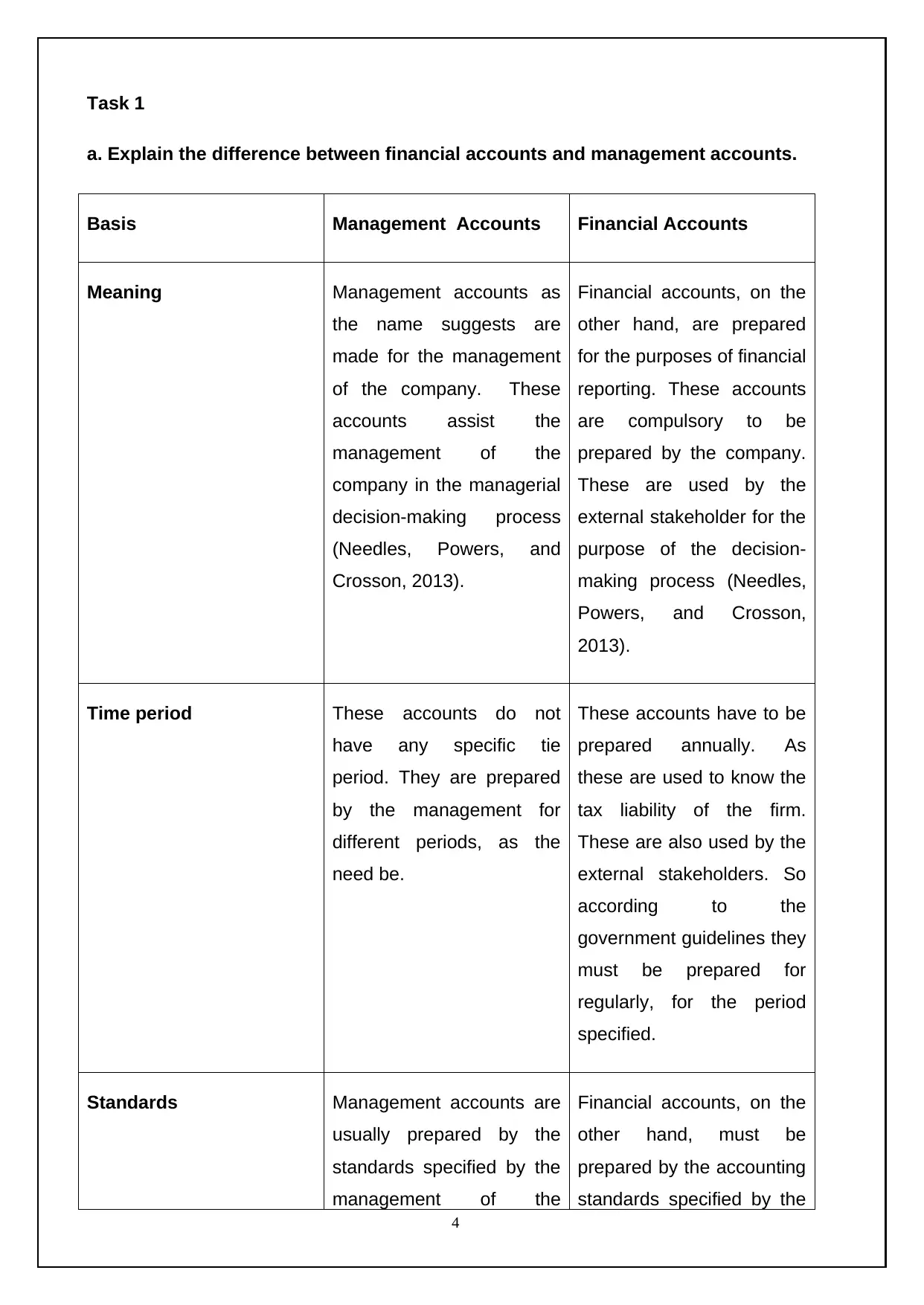
Task 1
a. Explain the difference between financial accounts and management accounts.
Basis Management Accounts Financial Accounts
Meaning Management accounts as
the name suggests are
made for the management
of the company. These
accounts assist the
management of the
company in the managerial
decision-making process
(Needles, Powers, and
Crosson, 2013).
Financial accounts, on the
other hand, are prepared
for the purposes of financial
reporting. These accounts
are compulsory to be
prepared by the company.
These are used by the
external stakeholder for the
purpose of the decision-
making process (Needles,
Powers, and Crosson,
2013).
Time period These accounts do not
have any specific tie
period. They are prepared
by the management for
different periods, as the
need be.
These accounts have to be
prepared annually. As
these are used to know the
tax liability of the firm.
These are also used by the
external stakeholders. So
according to the
government guidelines they
must be prepared for
regularly, for the period
specified.
Standards Management accounts are
usually prepared by the
standards specified by the
management of the
Financial accounts, on the
other hand, must be
prepared by the accounting
standards specified by the
4
a. Explain the difference between financial accounts and management accounts.
Basis Management Accounts Financial Accounts
Meaning Management accounts as
the name suggests are
made for the management
of the company. These
accounts assist the
management of the
company in the managerial
decision-making process
(Needles, Powers, and
Crosson, 2013).
Financial accounts, on the
other hand, are prepared
for the purposes of financial
reporting. These accounts
are compulsory to be
prepared by the company.
These are used by the
external stakeholder for the
purpose of the decision-
making process (Needles,
Powers, and Crosson,
2013).
Time period These accounts do not
have any specific tie
period. They are prepared
by the management for
different periods, as the
need be.
These accounts have to be
prepared annually. As
these are used to know the
tax liability of the firm.
These are also used by the
external stakeholders. So
according to the
government guidelines they
must be prepared for
regularly, for the period
specified.
Standards Management accounts are
usually prepared by the
standards specified by the
management of the
Financial accounts, on the
other hand, must be
prepared by the accounting
standards specified by the
4
Paraphrase This Document
Need a fresh take? Get an instant paraphrase of this document with our AI Paraphraser
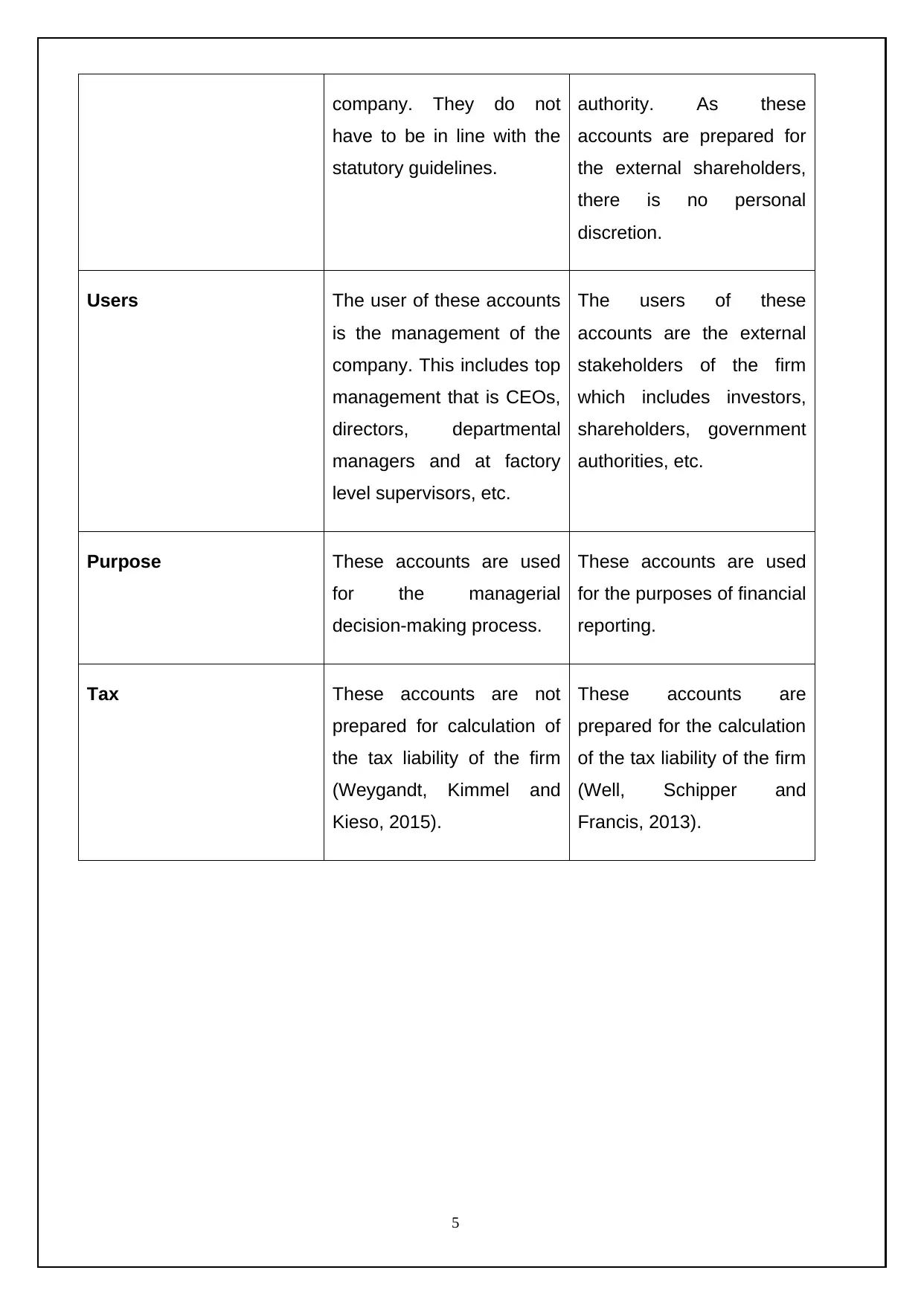
company. They do not
have to be in line with the
statutory guidelines.
authority. As these
accounts are prepared for
the external shareholders,
there is no personal
discretion.
Users The user of these accounts
is the management of the
company. This includes top
management that is CEOs,
directors, departmental
managers and at factory
level supervisors, etc.
The users of these
accounts are the external
stakeholders of the firm
which includes investors,
shareholders, government
authorities, etc.
Purpose These accounts are used
for the managerial
decision-making process.
These accounts are used
for the purposes of financial
reporting.
Tax These accounts are not
prepared for calculation of
the tax liability of the firm
(Weygandt, Kimmel and
Kieso, 2015).
These accounts are
prepared for the calculation
of the tax liability of the firm
(Well, Schipper and
Francis, 2013).
5
have to be in line with the
statutory guidelines.
authority. As these
accounts are prepared for
the external shareholders,
there is no personal
discretion.
Users The user of these accounts
is the management of the
company. This includes top
management that is CEOs,
directors, departmental
managers and at factory
level supervisors, etc.
The users of these
accounts are the external
stakeholders of the firm
which includes investors,
shareholders, government
authorities, etc.
Purpose These accounts are used
for the managerial
decision-making process.
These accounts are used
for the purposes of financial
reporting.
Tax These accounts are not
prepared for calculation of
the tax liability of the firm
(Weygandt, Kimmel and
Kieso, 2015).
These accounts are
prepared for the calculation
of the tax liability of the firm
(Well, Schipper and
Francis, 2013).
5
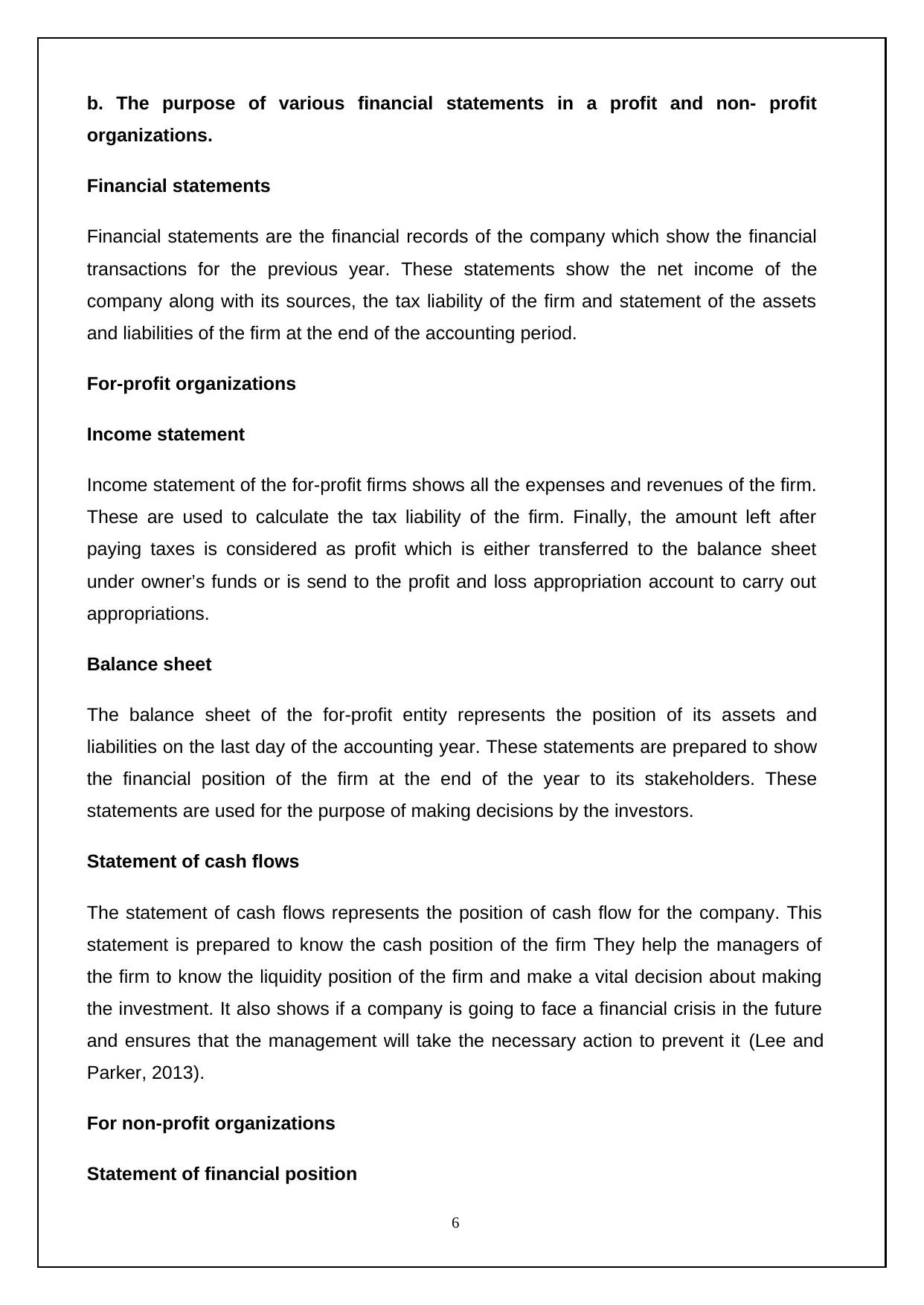
b. The purpose of various financial statements in a profit and non- profit
organizations.
Financial statements
Financial statements are the financial records of the company which show the financial
transactions for the previous year. These statements show the net income of the
company along with its sources, the tax liability of the firm and statement of the assets
and liabilities of the firm at the end of the accounting period.
For-profit organizations
Income statement
Income statement of the for-profit firms shows all the expenses and revenues of the firm.
These are used to calculate the tax liability of the firm. Finally, the amount left after
paying taxes is considered as profit which is either transferred to the balance sheet
under owner’s funds or is send to the profit and loss appropriation account to carry out
appropriations.
Balance sheet
The balance sheet of the for-profit entity represents the position of its assets and
liabilities on the last day of the accounting year. These statements are prepared to show
the financial position of the firm at the end of the year to its stakeholders. These
statements are used for the purpose of making decisions by the investors.
Statement of cash flows
The statement of cash flows represents the position of cash flow for the company. This
statement is prepared to know the cash position of the firm They help the managers of
the firm to know the liquidity position of the firm and make a vital decision about making
the investment. It also shows if a company is going to face a financial crisis in the future
and ensures that the management will take the necessary action to prevent it (Lee and
Parker, 2013).
For non-profit organizations
Statement of financial position
6
organizations.
Financial statements
Financial statements are the financial records of the company which show the financial
transactions for the previous year. These statements show the net income of the
company along with its sources, the tax liability of the firm and statement of the assets
and liabilities of the firm at the end of the accounting period.
For-profit organizations
Income statement
Income statement of the for-profit firms shows all the expenses and revenues of the firm.
These are used to calculate the tax liability of the firm. Finally, the amount left after
paying taxes is considered as profit which is either transferred to the balance sheet
under owner’s funds or is send to the profit and loss appropriation account to carry out
appropriations.
Balance sheet
The balance sheet of the for-profit entity represents the position of its assets and
liabilities on the last day of the accounting year. These statements are prepared to show
the financial position of the firm at the end of the year to its stakeholders. These
statements are used for the purpose of making decisions by the investors.
Statement of cash flows
The statement of cash flows represents the position of cash flow for the company. This
statement is prepared to know the cash position of the firm They help the managers of
the firm to know the liquidity position of the firm and make a vital decision about making
the investment. It also shows if a company is going to face a financial crisis in the future
and ensures that the management will take the necessary action to prevent it (Lee and
Parker, 2013).
For non-profit organizations
Statement of financial position
6
⊘ This is a preview!⊘
Do you want full access?
Subscribe today to unlock all pages.

Trusted by 1+ million students worldwide

This statement is like to the balance sheet of the for-profit company. The difference is
that the net assets section takes place of the equity section that is used in the for-profit
financial statements. Secondly. The assets section of the balance sheet is divided into
unrestricted, permanently restricted and temporarily restricted net assets (Drucker, 2012).
Statement of activities
This statement shows the revenues and expenses of the non-profit for the reporting
period. Thee revenues and expenses of the firm are divided into three categories namely
unrestricted, permanently restricted and temporarily restricted. The revenue can be from
the following sources contribution, member dues, grants and program fees. The expense
of the entity includes program expenses and support service expenses. After the above
calculation, the net effect of the above statement will be shown as a change in net assets
(Drucker, 2012).
Statement of cash flows
These statements show the cash inflows and cash outflows of the firm. This statement is
important as the statement of cash flows is not based on the accrual principle of
accounting which says that the accounting transactions are recording in the books of
accounts when they take place not when they are settled in cash. This creates a
misbalance in the cash balances of the firm. Cash flow statement aims to correct this by
only recording cash transactions Further noncash transaction are also removed and it
helps to know the real cash balances of the firm (Anheeler, 2014).
Statement of functional expenses
This statement is used to show how expenses are incurred for each functional area of a
non-profit entity. The functional areas of the non-profit entity include –
Management and administration
Fundraising
Programs (Anheeler, 2014)
7
that the net assets section takes place of the equity section that is used in the for-profit
financial statements. Secondly. The assets section of the balance sheet is divided into
unrestricted, permanently restricted and temporarily restricted net assets (Drucker, 2012).
Statement of activities
This statement shows the revenues and expenses of the non-profit for the reporting
period. Thee revenues and expenses of the firm are divided into three categories namely
unrestricted, permanently restricted and temporarily restricted. The revenue can be from
the following sources contribution, member dues, grants and program fees. The expense
of the entity includes program expenses and support service expenses. After the above
calculation, the net effect of the above statement will be shown as a change in net assets
(Drucker, 2012).
Statement of cash flows
These statements show the cash inflows and cash outflows of the firm. This statement is
important as the statement of cash flows is not based on the accrual principle of
accounting which says that the accounting transactions are recording in the books of
accounts when they take place not when they are settled in cash. This creates a
misbalance in the cash balances of the firm. Cash flow statement aims to correct this by
only recording cash transactions Further noncash transaction are also removed and it
helps to know the real cash balances of the firm (Anheeler, 2014).
Statement of functional expenses
This statement is used to show how expenses are incurred for each functional area of a
non-profit entity. The functional areas of the non-profit entity include –
Management and administration
Fundraising
Programs (Anheeler, 2014)
7
Paraphrase This Document
Need a fresh take? Get an instant paraphrase of this document with our AI Paraphraser
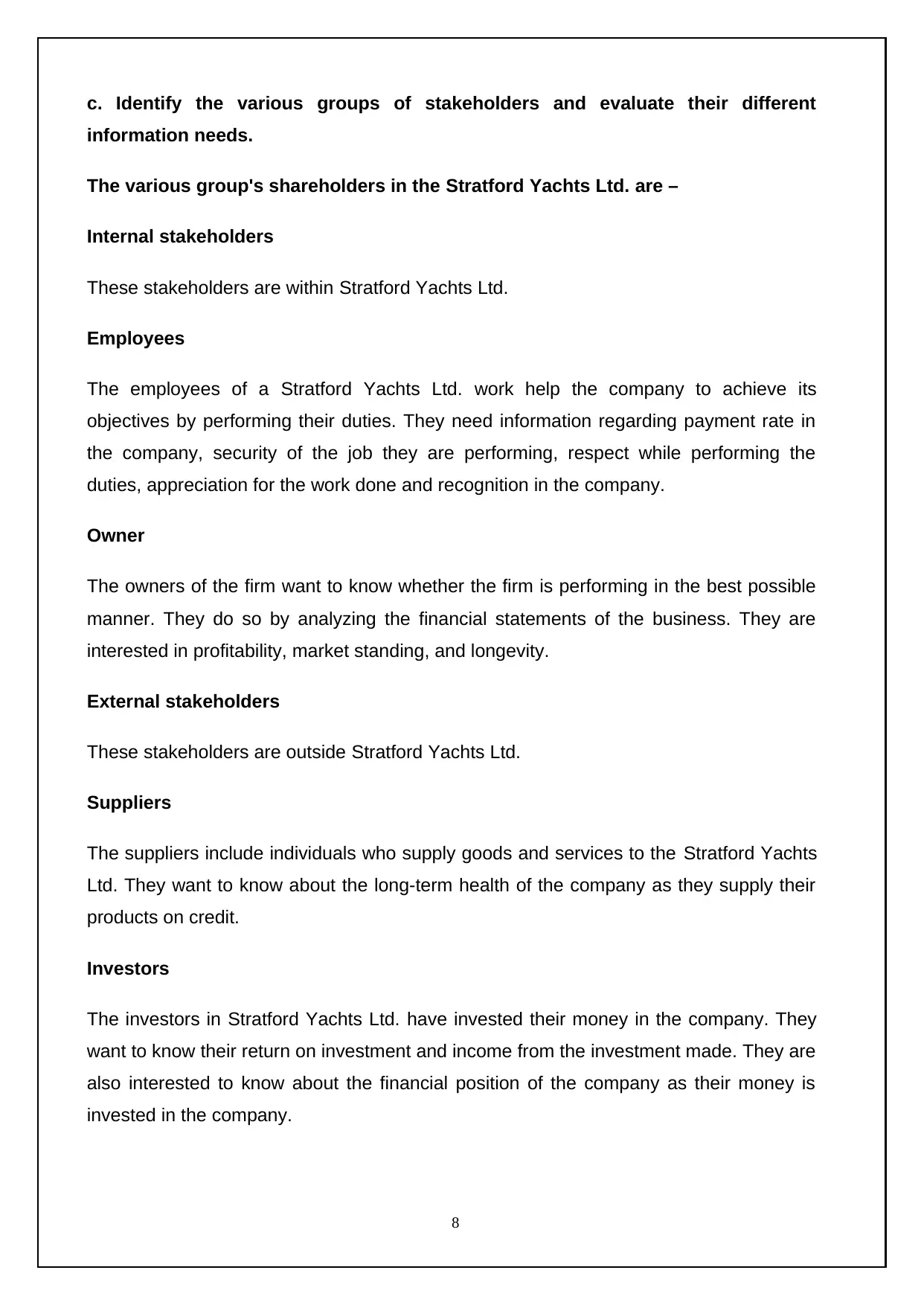
c. Identify the various groups of stakeholders and evaluate their different
information needs.
The various group's shareholders in the Stratford Yachts Ltd. are –
Internal stakeholders
These stakeholders are within Stratford Yachts Ltd.
Employees
The employees of a Stratford Yachts Ltd. work help the company to achieve its
objectives by performing their duties. They need information regarding payment rate in
the company, security of the job they are performing, respect while performing the
duties, appreciation for the work done and recognition in the company.
Owner
The owners of the firm want to know whether the firm is performing in the best possible
manner. They do so by analyzing the financial statements of the business. They are
interested in profitability, market standing, and longevity.
External stakeholders
These stakeholders are outside Stratford Yachts Ltd.
Suppliers
The suppliers include individuals who supply goods and services to the Stratford Yachts
Ltd. They want to know about the long-term health of the company as they supply their
products on credit.
Investors
The investors in Stratford Yachts Ltd. have invested their money in the company. They
want to know their return on investment and income from the investment made. They are
also interested to know about the financial position of the company as their money is
invested in the company.
8
information needs.
The various group's shareholders in the Stratford Yachts Ltd. are –
Internal stakeholders
These stakeholders are within Stratford Yachts Ltd.
Employees
The employees of a Stratford Yachts Ltd. work help the company to achieve its
objectives by performing their duties. They need information regarding payment rate in
the company, security of the job they are performing, respect while performing the
duties, appreciation for the work done and recognition in the company.
Owner
The owners of the firm want to know whether the firm is performing in the best possible
manner. They do so by analyzing the financial statements of the business. They are
interested in profitability, market standing, and longevity.
External stakeholders
These stakeholders are outside Stratford Yachts Ltd.
Suppliers
The suppliers include individuals who supply goods and services to the Stratford Yachts
Ltd. They want to know about the long-term health of the company as they supply their
products on credit.
Investors
The investors in Stratford Yachts Ltd. have invested their money in the company. They
want to know their return on investment and income from the investment made. They are
also interested to know about the financial position of the company as their money is
invested in the company.
8
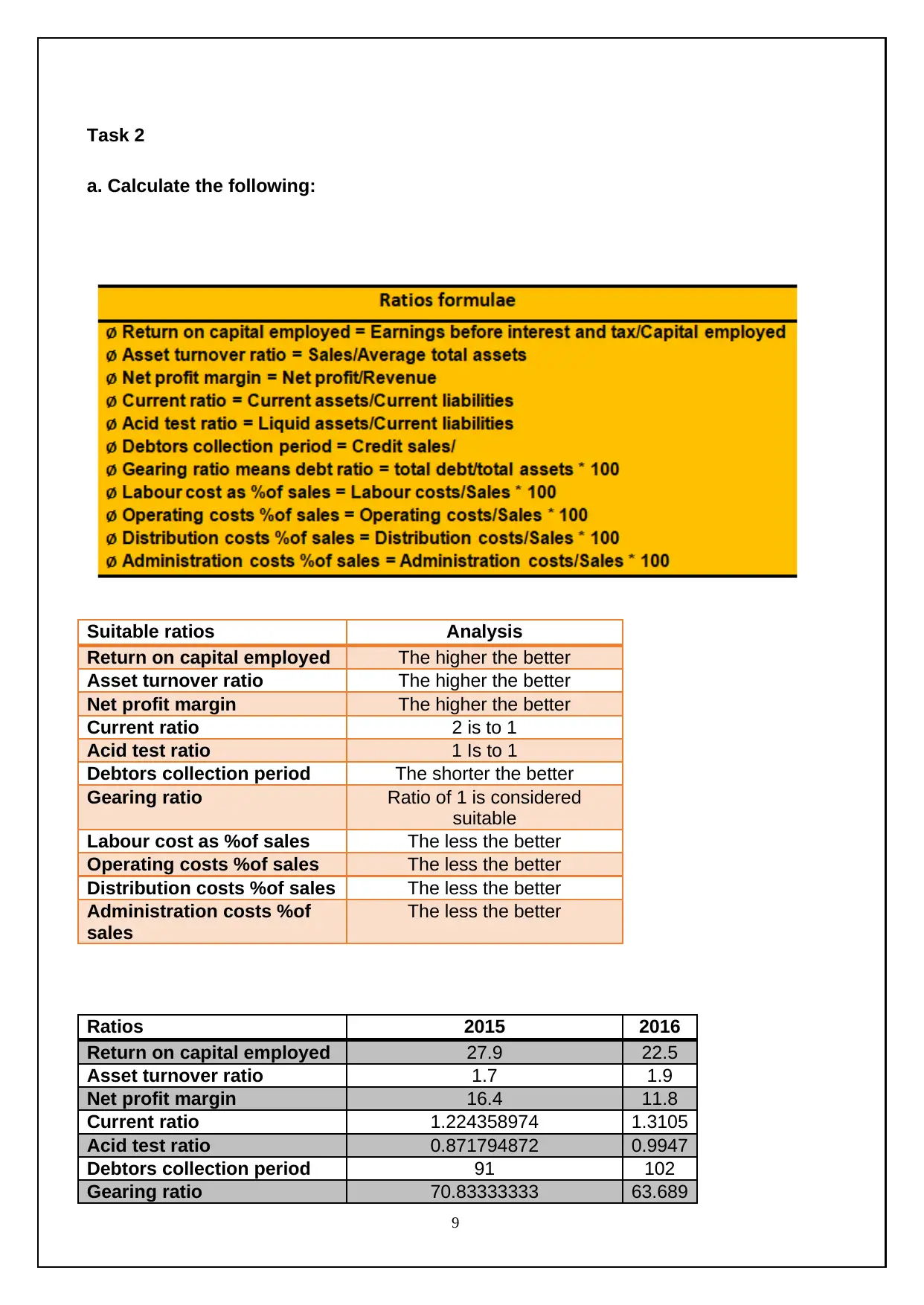
Task 2
a. Calculate the following:
Suitable ratios Analysis
Return on capital employed The higher the better
Asset turnover ratio The higher the better
Net profit margin The higher the better
Current ratio 2 is to 1
Acid test ratio 1 Is to 1
Debtors collection period The shorter the better
Gearing ratio Ratio of 1 is considered
suitable
Labour cost as %of sales The less the better
Operating costs %of sales The less the better
Distribution costs %of sales The less the better
Administration costs %of
sales
The less the better
Ratios 2015 2016
Return on capital employed 27.9 22.5
Asset turnover ratio 1.7 1.9
Net profit margin 16.4 11.8
Current ratio 1.224358974 1.3105
Acid test ratio 0.871794872 0.9947
Debtors collection period 91 102
Gearing ratio 70.83333333 63.689
9
a. Calculate the following:
Suitable ratios Analysis
Return on capital employed The higher the better
Asset turnover ratio The higher the better
Net profit margin The higher the better
Current ratio 2 is to 1
Acid test ratio 1 Is to 1
Debtors collection period The shorter the better
Gearing ratio Ratio of 1 is considered
suitable
Labour cost as %of sales The less the better
Operating costs %of sales The less the better
Distribution costs %of sales The less the better
Administration costs %of
sales
The less the better
Ratios 2015 2016
Return on capital employed 27.9 22.5
Asset turnover ratio 1.7 1.9
Net profit margin 16.4 11.8
Current ratio 1.224358974 1.3105
Acid test ratio 0.871794872 0.9947
Debtors collection period 91 102
Gearing ratio 70.83333333 63.689
9
⊘ This is a preview!⊘
Do you want full access?
Subscribe today to unlock all pages.

Trusted by 1+ million students worldwide
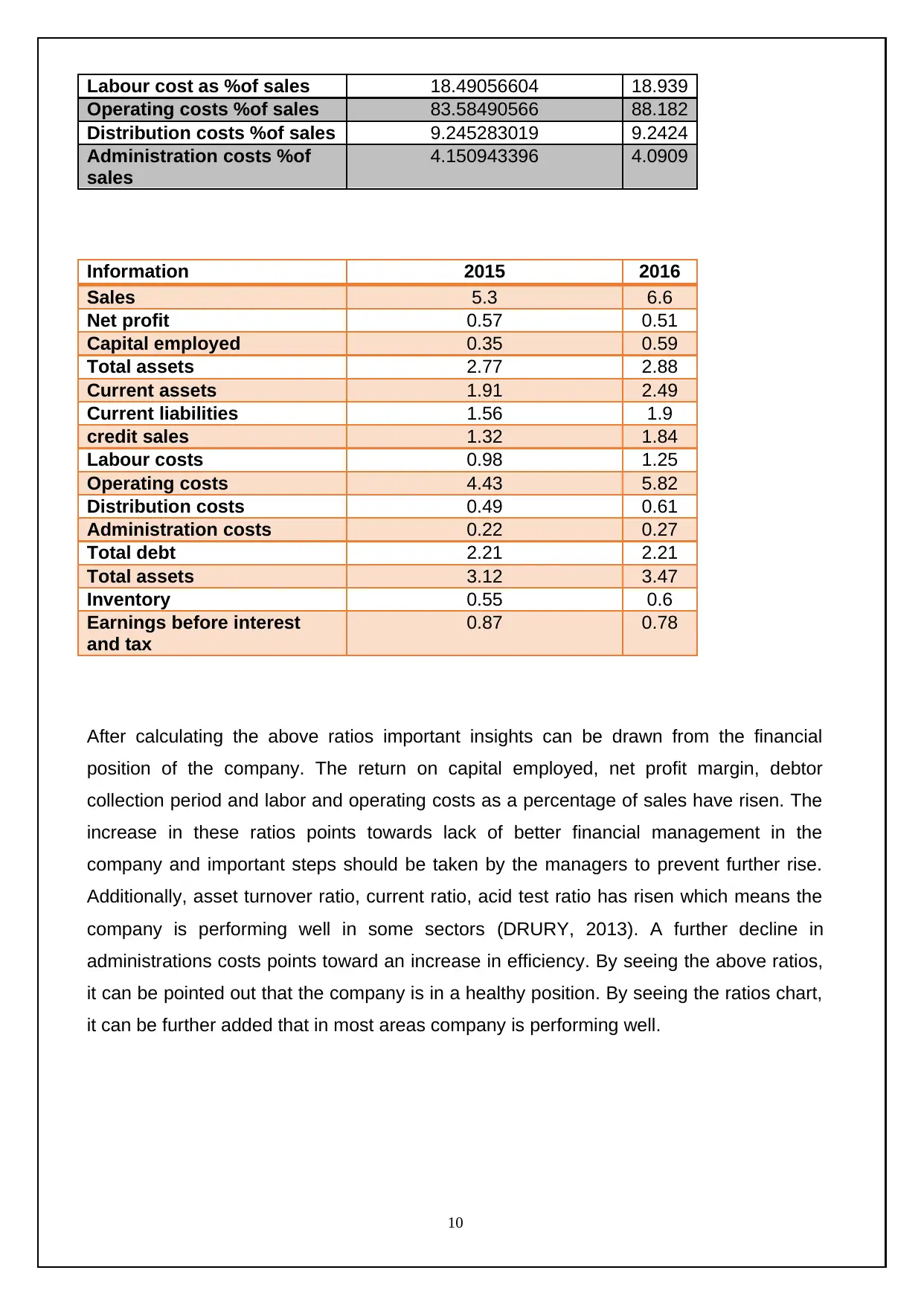
Labour cost as %of sales 18.49056604 18.939
Operating costs %of sales 83.58490566 88.182
Distribution costs %of sales 9.245283019 9.2424
Administration costs %of
sales
4.150943396 4.0909
Information 2015 2016
Sales 5.3 6.6
Net profit 0.57 0.51
Capital employed 0.35 0.59
Total assets 2.77 2.88
Current assets 1.91 2.49
Current liabilities 1.56 1.9
credit sales 1.32 1.84
Labour costs 0.98 1.25
Operating costs 4.43 5.82
Distribution costs 0.49 0.61
Administration costs 0.22 0.27
Total debt 2.21 2.21
Total assets 3.12 3.47
Inventory 0.55 0.6
Earnings before interest
and tax
0.87 0.78
After calculating the above ratios important insights can be drawn from the financial
position of the company. The return on capital employed, net profit margin, debtor
collection period and labor and operating costs as a percentage of sales have risen. The
increase in these ratios points towards lack of better financial management in the
company and important steps should be taken by the managers to prevent further rise.
Additionally, asset turnover ratio, current ratio, acid test ratio has risen which means the
company is performing well in some sectors (DRURY, 2013). A further decline in
administrations costs points toward an increase in efficiency. By seeing the above ratios,
it can be pointed out that the company is in a healthy position. By seeing the ratios chart,
it can be further added that in most areas company is performing well.
10
Operating costs %of sales 83.58490566 88.182
Distribution costs %of sales 9.245283019 9.2424
Administration costs %of
sales
4.150943396 4.0909
Information 2015 2016
Sales 5.3 6.6
Net profit 0.57 0.51
Capital employed 0.35 0.59
Total assets 2.77 2.88
Current assets 1.91 2.49
Current liabilities 1.56 1.9
credit sales 1.32 1.84
Labour costs 0.98 1.25
Operating costs 4.43 5.82
Distribution costs 0.49 0.61
Administration costs 0.22 0.27
Total debt 2.21 2.21
Total assets 3.12 3.47
Inventory 0.55 0.6
Earnings before interest
and tax
0.87 0.78
After calculating the above ratios important insights can be drawn from the financial
position of the company. The return on capital employed, net profit margin, debtor
collection period and labor and operating costs as a percentage of sales have risen. The
increase in these ratios points towards lack of better financial management in the
company and important steps should be taken by the managers to prevent further rise.
Additionally, asset turnover ratio, current ratio, acid test ratio has risen which means the
company is performing well in some sectors (DRURY, 2013). A further decline in
administrations costs points toward an increase in efficiency. By seeing the above ratios,
it can be pointed out that the company is in a healthy position. By seeing the ratios chart,
it can be further added that in most areas company is performing well.
10
Paraphrase This Document
Need a fresh take? Get an instant paraphrase of this document with our AI Paraphraser
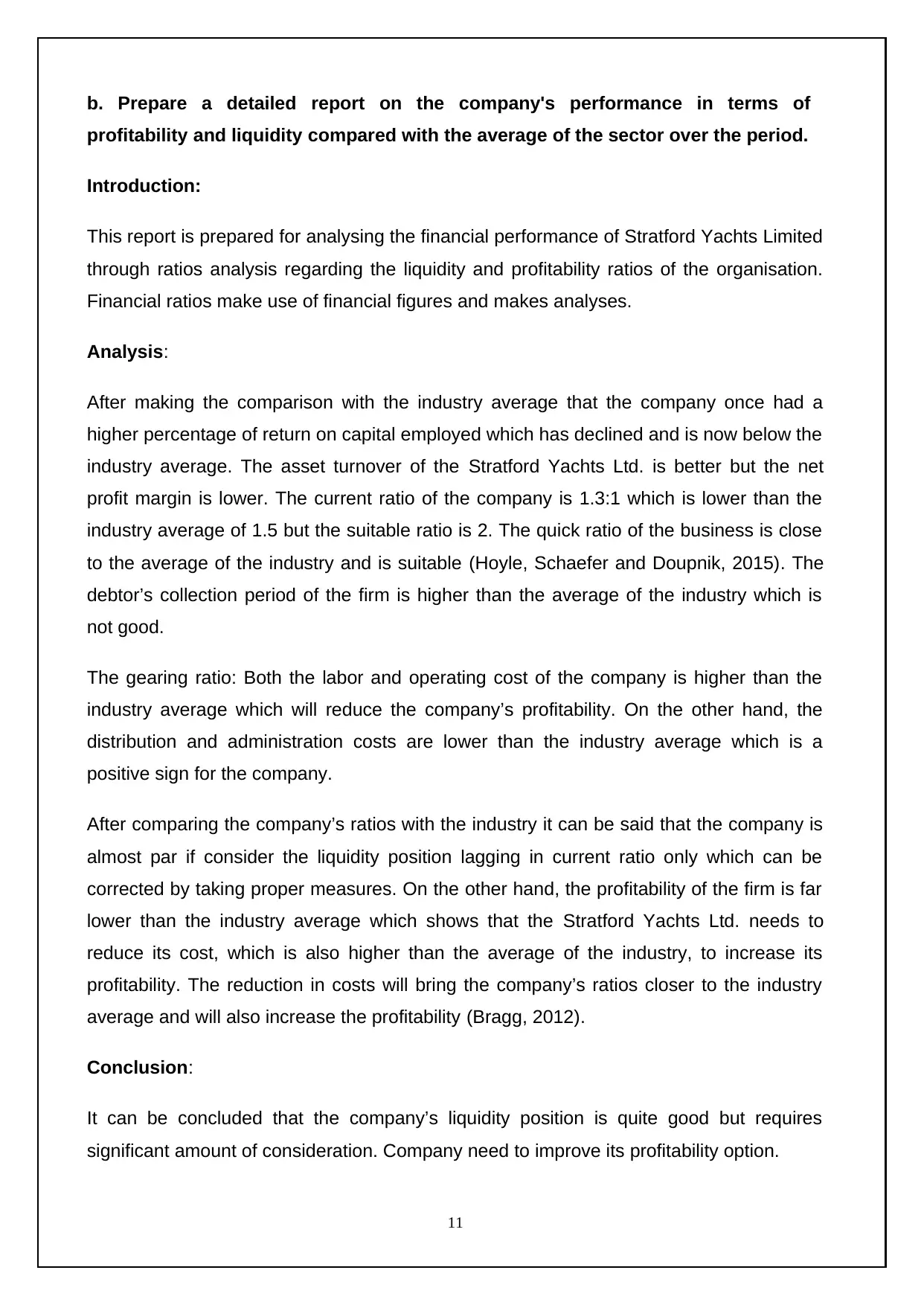
b. Prepare a detailed report on the company's performance in terms of
profitability and liquidity compared with the average of the sector over the period.
Introduction:
This report is prepared for analysing the financial performance of Stratford Yachts Limited
through ratios analysis regarding the liquidity and profitability ratios of the organisation.
Financial ratios make use of financial figures and makes analyses.
Analysis:
After making the comparison with the industry average that the company once had a
higher percentage of return on capital employed which has declined and is now below the
industry average. The asset turnover of the Stratford Yachts Ltd. is better but the net
profit margin is lower. The current ratio of the company is 1.3:1 which is lower than the
industry average of 1.5 but the suitable ratio is 2. The quick ratio of the business is close
to the average of the industry and is suitable (Hoyle, Schaefer and Doupnik, 2015). The
debtor’s collection period of the firm is higher than the average of the industry which is
not good.
The gearing ratio: Both the labor and operating cost of the company is higher than the
industry average which will reduce the company’s profitability. On the other hand, the
distribution and administration costs are lower than the industry average which is a
positive sign for the company.
After comparing the company’s ratios with the industry it can be said that the company is
almost par if consider the liquidity position lagging in current ratio only which can be
corrected by taking proper measures. On the other hand, the profitability of the firm is far
lower than the industry average which shows that the Stratford Yachts Ltd. needs to
reduce its cost, which is also higher than the average of the industry, to increase its
profitability. The reduction in costs will bring the company’s ratios closer to the industry
average and will also increase the profitability (Bragg, 2012).
Conclusion:
It can be concluded that the company’s liquidity position is quite good but requires
significant amount of consideration. Company need to improve its profitability option.
11
profitability and liquidity compared with the average of the sector over the period.
Introduction:
This report is prepared for analysing the financial performance of Stratford Yachts Limited
through ratios analysis regarding the liquidity and profitability ratios of the organisation.
Financial ratios make use of financial figures and makes analyses.
Analysis:
After making the comparison with the industry average that the company once had a
higher percentage of return on capital employed which has declined and is now below the
industry average. The asset turnover of the Stratford Yachts Ltd. is better but the net
profit margin is lower. The current ratio of the company is 1.3:1 which is lower than the
industry average of 1.5 but the suitable ratio is 2. The quick ratio of the business is close
to the average of the industry and is suitable (Hoyle, Schaefer and Doupnik, 2015). The
debtor’s collection period of the firm is higher than the average of the industry which is
not good.
The gearing ratio: Both the labor and operating cost of the company is higher than the
industry average which will reduce the company’s profitability. On the other hand, the
distribution and administration costs are lower than the industry average which is a
positive sign for the company.
After comparing the company’s ratios with the industry it can be said that the company is
almost par if consider the liquidity position lagging in current ratio only which can be
corrected by taking proper measures. On the other hand, the profitability of the firm is far
lower than the industry average which shows that the Stratford Yachts Ltd. needs to
reduce its cost, which is also higher than the average of the industry, to increase its
profitability. The reduction in costs will bring the company’s ratios closer to the industry
average and will also increase the profitability (Bragg, 2012).
Conclusion:
It can be concluded that the company’s liquidity position is quite good but requires
significant amount of consideration. Company need to improve its profitability option.
11
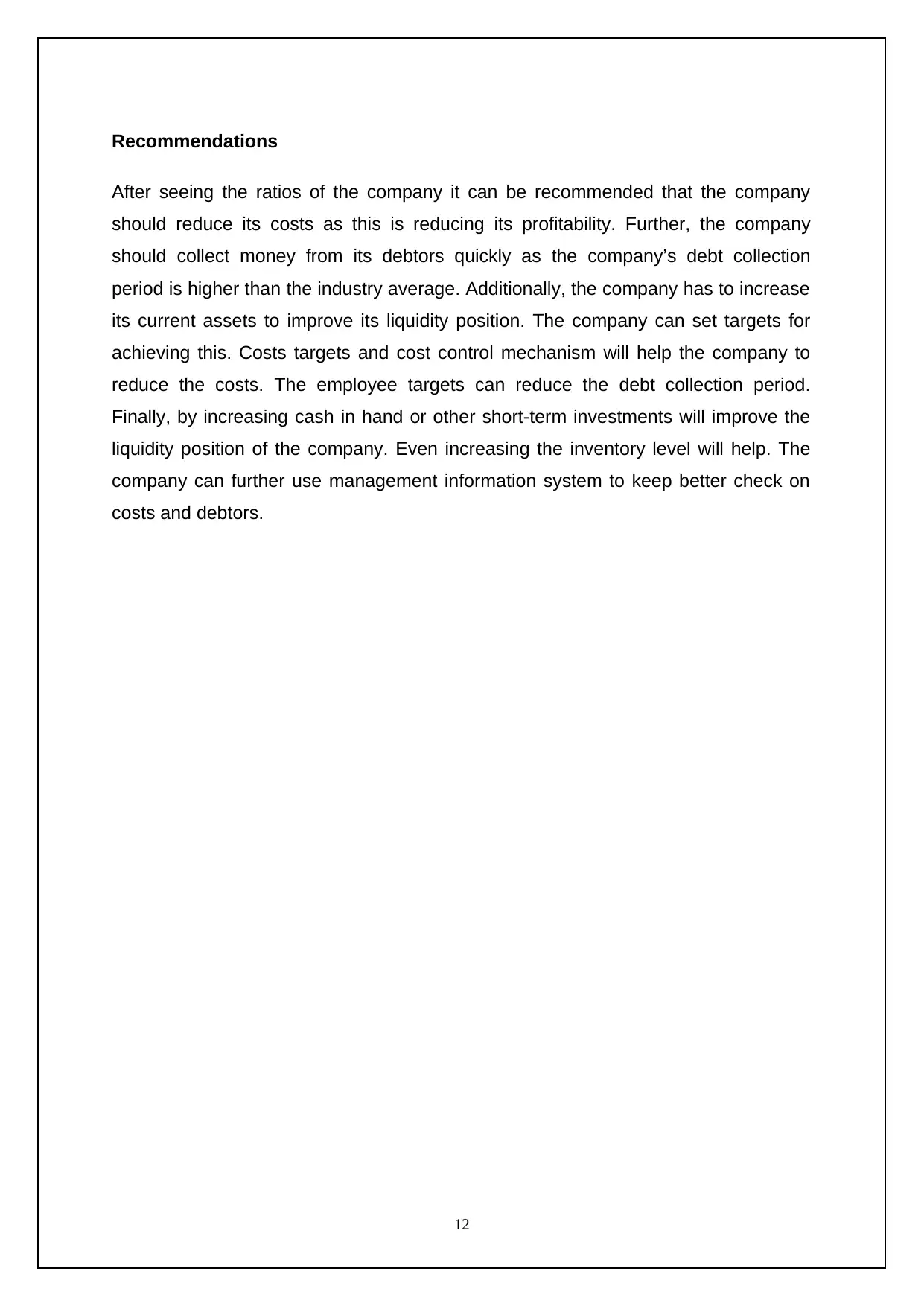
Recommendations
After seeing the ratios of the company it can be recommended that the company
should reduce its costs as this is reducing its profitability. Further, the company
should collect money from its debtors quickly as the company’s debt collection
period is higher than the industry average. Additionally, the company has to increase
its current assets to improve its liquidity position. The company can set targets for
achieving this. Costs targets and cost control mechanism will help the company to
reduce the costs. The employee targets can reduce the debt collection period.
Finally, by increasing cash in hand or other short-term investments will improve the
liquidity position of the company. Even increasing the inventory level will help. The
company can further use management information system to keep better check on
costs and debtors.
12
After seeing the ratios of the company it can be recommended that the company
should reduce its costs as this is reducing its profitability. Further, the company
should collect money from its debtors quickly as the company’s debt collection
period is higher than the industry average. Additionally, the company has to increase
its current assets to improve its liquidity position. The company can set targets for
achieving this. Costs targets and cost control mechanism will help the company to
reduce the costs. The employee targets can reduce the debt collection period.
Finally, by increasing cash in hand or other short-term investments will improve the
liquidity position of the company. Even increasing the inventory level will help. The
company can further use management information system to keep better check on
costs and debtors.
12
⊘ This is a preview!⊘
Do you want full access?
Subscribe today to unlock all pages.

Trusted by 1+ million students worldwide

References
Anheier, H.K., 2014. Nonprofit organizations: Theory, management, policy.
Routledge.
Bragg, S.M., 2012. Business ratios and formulas: a comprehensive guide
(Vol. 577). John Wiley & Sons
Drucker, P., 2012. Managing the non-profit organization. Routledge.
DRURY, C.M., 2013. Management and cost accounting. Springer.
Hoyle, J.B., Schaefer, T. and Doupnik, T., 2015. Advanced accounting.
McGraw Hill.
Lee, T.A. and Parker, R.H. eds., 2013. Towards a theory and practice of cash
flow accounting (RLE Accounting) (Vol. 50). Routledge.
Needles, B.E., Powers, M. and Crosson, S.V., 2013. Financial and managerial
accounting. Cengage Learning.
Weil, R.L., Schipper, K. and Francis, J., 2013. Financial accounting: an
introduction to concepts, methods and uses. Cengage Learning.
Weygandt, J.J., Kimmel, P.D. and Kieso, D.E., 2015. Financial & managerial
accounting. John Wiley & Sons.
13
Anheier, H.K., 2014. Nonprofit organizations: Theory, management, policy.
Routledge.
Bragg, S.M., 2012. Business ratios and formulas: a comprehensive guide
(Vol. 577). John Wiley & Sons
Drucker, P., 2012. Managing the non-profit organization. Routledge.
DRURY, C.M., 2013. Management and cost accounting. Springer.
Hoyle, J.B., Schaefer, T. and Doupnik, T., 2015. Advanced accounting.
McGraw Hill.
Lee, T.A. and Parker, R.H. eds., 2013. Towards a theory and practice of cash
flow accounting (RLE Accounting) (Vol. 50). Routledge.
Needles, B.E., Powers, M. and Crosson, S.V., 2013. Financial and managerial
accounting. Cengage Learning.
Weil, R.L., Schipper, K. and Francis, J., 2013. Financial accounting: an
introduction to concepts, methods and uses. Cengage Learning.
Weygandt, J.J., Kimmel, P.D. and Kieso, D.E., 2015. Financial & managerial
accounting. John Wiley & Sons.
13
1 out of 13
Related Documents
Your All-in-One AI-Powered Toolkit for Academic Success.
+13062052269
info@desklib.com
Available 24*7 on WhatsApp / Email
![[object Object]](/_next/static/media/star-bottom.7253800d.svg)
Unlock your academic potential
© 2024 | Zucol Services PVT LTD | All rights reserved.





